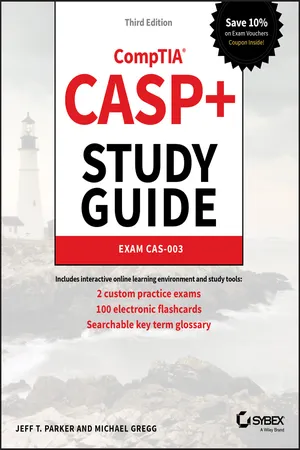
CASP+ CompTIA Advanced Security Practitioner Study Guide
Exam CAS-003
Jeff T. Parker, Michael Gregg
- English
- ePUB (apto para móviles)
- Disponible en iOS y Android
CASP+ CompTIA Advanced Security Practitioner Study Guide
Exam CAS-003
Jeff T. Parker, Michael Gregg
Información del libro
Comprehensive coverage of the new CASP+ exam, with hands-on practice and interactive study tools
The CASP+ CompTIA Advanced Security Practitioner Study Guide: Exam CAS-003, Third Edition, offers invaluable preparation for exam CAS-003. Covering 100 percent of the exam objectives, this book provides expert walk-through of essential security concepts and processes to help you tackle this challenging exam with full confidence. Practical examples and real-world insights illustrate critical topics and show what essential practices look like on the ground, while detailed explanations of technical and business concepts give you the background you need to apply identify and implement appropriate security solutions. End-of-chapter reviews help solidify your understanding of each objective, and cutting-edge exam prep software features electronic flashcards, hands-on lab exercises, and hundreds of practice questions to help you test your knowledge in advance of the exam.
The next few years will bring a 45-fold increase in digital data, and at least one third of that data will pass through the cloud. The level of risk to data everywhere is growing in parallel, and organizations are in need of qualified data security professionals; the CASP+ certification validates this in-demand skill set, and this book is your ideal resource for passing the exam.
- Master cryptography, controls, vulnerability analysis, and network security
- Identify risks and execute mitigation planning, strategies, and controls
- Analyze security trends and their impact on your organization
- Integrate business and technical components to achieve a secure enterprise architecture
CASP+ meets the ISO 17024 standard, and is approved by U.S. Department of Defense to fulfill Directive 8570.01-M requirements. It is also compliant with government regulations under the Federal Information Security Management Act (FISMA). As such, this career-building credential makes you in demand in the marketplace and shows that you are qualified to address enterprise-level security concerns. The CASP+ CompTIA Advanced Security Practitioner Study Guide: Exam CAS-003, Third Edition, is the preparation resource you need to take the next big step for your career and pass with flying colors.
Preguntas frecuentes
Información
Chapter 1
Cryptographic Tools and Techniques
- 2.1 Analyze a scenario and integrate network and security components, concepts and architectures to meet security requirements.

- 2.1 Analyze a scenario and integrate network and security components, concepts and architectures to meet security requirements.

- Physical and virtual network and security devices
- HSM
- Physical and virtual network and security devices
- 2.3 Analyze a scenario to integrate security controls for mobile and small form factor devices to meet security requirements.

- Security implications/privacy concerns
- TPM
- Security implications/privacy concerns
- 4.4 Given a scenario, implement cryptographic techniques.

- Techniques
- Key stretching
- Hashing
- Digital signature
- Message authentication
- Code signing
- Pseudo-random number generation
- Perfect forward secrecy
- Data-at-rest encryption
- Disk
- Block
- File
- Record
- Steganography
- Implementations
- DRM
- Watermarking
- GPG
- SSL/TLS
- SSH
- S/MIME
- Cryptographic applications and proper/improper implementations
- Strength
- Performance
- Feasibility to implement
- Interoperability
- Stream vs. block
- PKI
- Wild card
- OCSP vs. CRL
- Issuance to entities
- Key escrow
- Certificate
- Tokens
- Stapling
- Pinning
- Cryptocurrency/blockchain
- Techniques

- Provide a locking cable for every laptop user in the organization.
- Enforce full disk encryption for every mobile device.
The History of Cryptography
Cryptographic Services
Cryptographic Goals
